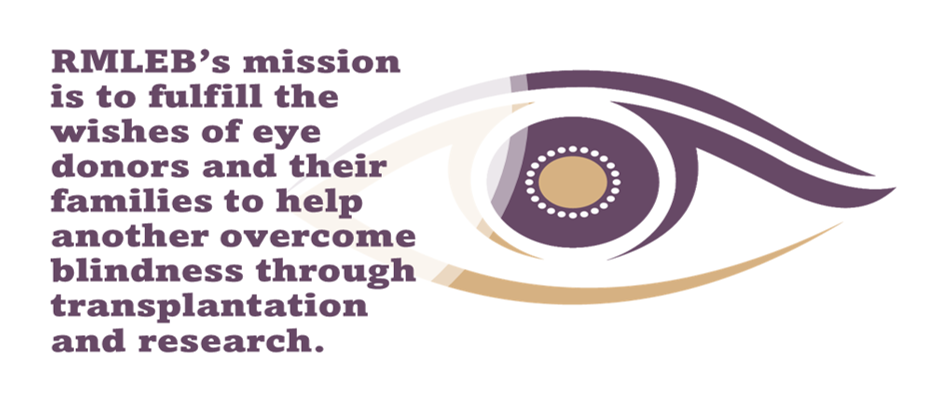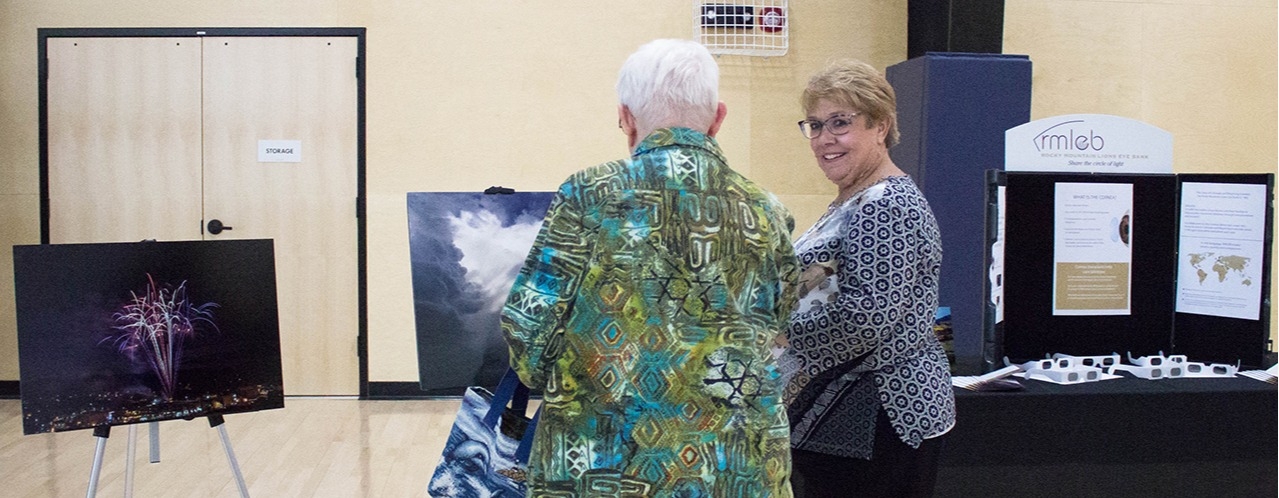Making Connections with Hospital Care Teams
A Day in the Life of Rae, RMLEB Community and Professional Relations Coordinator
By Kerry Halladay - August 17, 2023
Rae Price has always worked in communications ever since she left her family’s farm in Nebraska. Her earlier work was in reporting local news in a rural town, sharing news about agriculture, and working with ranchers to be better communicators themselves. As a result, her work with the Rocky Mountain Lions Eye Bank (RMLEB) as a community and professional relations (CPR) coordinator is both familiar and new. It is about communication and relationship building, but with a slightly different message.
“Most of my previous work was in agricultural-related jobs; a completely non-medical background,” Rae summarized. “But the things I have learned since coming to work at RMLEB are fascinating.”

The mission statement of the Rocky Mountain Lions Eye Bank.
Like many people, Rae was working in a temporary job during the chaos of the early pandemic. But she jumped at the opportunity to work for RMLEB.
“When I saw the posting, I thought it would be a great opportunity to get back into my career field and with an organization with an inspiring mission,” she said. “It was a great decision on my part.”
A Day in Rae’s Life
Unlike some of the other roles at RMLEB, members of the CPR team don't have a set daily routine. The role is focused on building and maintaining relationships with partners like hospital staff and donor families. Every day can be very different.
“My main role is to be a liaison between RMLEB and the hospitals that we work with for [eye] tissue recovery,” Rae explained.
This liaison work comes in many forms and can differ based on the needs of the hospital and its staff. Each one is unique.
On the more predictable side, Rae compiles reports for over 40 hospitals every month. These reports outline relevant eye tissue donor information for the hospitals. This includes how many potential donors a hospital had each month, how many tissues RMLEB staff recovered, how many tissues were used for either transplant or research, and where those placed tissues went throughout the U.S. or the world.
Other monthly duties include attending and participating as a member of the donor resource team meetings at her assigned hospitals. A donor resource team is a group of passionate staff within each hospital who advocate for and increase awareness of eye, organ and tissue donation within the hospital.
Being a liaison also comes with less regular activities. This can include reoccurring annual events like the Donor Dash or participating in National Donate Life Month or Eye Donation Month activities. It can also include ad-hoc outreach efforts like setting up informational tables or giving presentations as hospitals need them. Many of these less predictable activities are educational, such as the designated requestor trainings.
“Designated requestors are the people who approach family members to ask for donation consent for decedents who are not on the donor registry,” Rae explained. “Within the hospital, only people who have received special training are legally allowed to talk to next of kin about donation. Hospital chaplains, nurse managers or supervisors and other nurses are the ones who get trained. It is a voluntary role in addition to their normal duties.”
Quarterly or annual activities can include things like helping with reports for the Lions Clubs of Colorado and Wyoming, working on the RMLEB annual report, developing and executing outreach events like the Circle of Light Photo Project, working on blog posts, and presenting at conferences or community groups.
Rae said these presentations are a great opportunity to talk about eye donation.
“I love telling people about what we do, and watching the reaction when I say our work helps to restore sight to people in over 15 countries each year.”
Personal Connections
One of the best parts of the work for Rae is the personal connections that happen as a matter of course in her role. In addition to working with assigned hospitals, CPR team members have focused projects they work on. For Rae, this is interacting with the recipients and donor families through RMLEB’s aftercare program.
“One of my favorite duties is coordinating letters between cornea recipients and the next of kin,” she said.
When a transplant takes place, the donor family and the recipient have the option to write letters to one another. Rae explained that the letters are routed through and screened by RMLEB to maintain confidentiality.
“These letters are very touching, hearing from recipients and how their life has changed, and expressing their appreciation often results in some tears on my part,” Rae said. “The letters from donor families are similarly moving as they explain a feeling of comfort in the loss of their loved one knowing another person was helped because of the eye tissue donation.”
Rae also does a lot of work with recipients who want to advocate on behalf of the eye bank. This includes working with them to find opportunities to tell their story at public events.
“One of my favorite stories comes from a recipient who I met soon after starting at RMLEB,” Rae said. This recipient had vision problems since childhood. She eventually required a cornea transplant in her 30s when she was legally blind.
“Now she can drive herself without being dependent on her husband or others,” Rae went on. “She can interact more fully with her grandchildren, and she has a rewarding job. She ‘sparkles’ when she talks about her transplant and how it changed her life. To me, that is inspiring.”
Old Skills in New Settings
Rae’s experience as a reporter had her communicating with a wide variety of people at a moment’s notice. Her time as a spokesperson trainer in the beef industry also had her coaching ranchers on how to tell their story well to a national audience. Both engrained skills have served her well at RMLEB, particularly when it comes to the designated requestor training.
“Approaching a family about donation isn't a ‘presentation’ designated requestors give. But my previous experience helps me teach them to use the guideline messages and put it their own words for a more comfortable conversation,” Rae explained.
Rae is also a people person, she said. So, the opportunity to meet with many different people gives her a unique opportunity.
“These public presentations give me a chance to go interact and share RMLEB's positive message or learn more about the people we serve.”
The role has also fed Rae's natural curiosity and need to investigate. Still, she said she’s a bit surprised at how fascinating she has found the donation recovery and transplant process.
“As someone with no medical background and a somewhat low tolerance for what I thought might be ‘icky,’ I have embraced the organization's work. I love learning about all the ways eye tissue donation can help enhance the lives of recipients.”
Given her experience, she advised anyone thinking about getting into the world of eye banking to keep an open mind.
“And be prepared for the emotions that may come,” she added. “Our work is not possible without someone losing their life.”
But the bright side comes when an individual made the decision to be a donor, or their loved ones make the decision to donate their tissues after their death. That is when the generosity of others to give the gift of sight shines through the sadness of death.
“We not only have a local impact, but the organization’s work is worldwide,” Rae added. There were hundreds of tissues transplanted abroad last year. “So, the work is very far reaching and can be very rewarding.”
